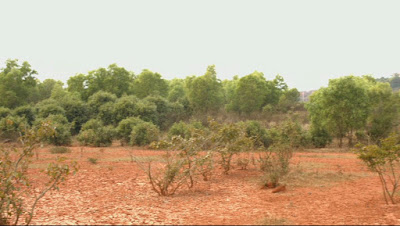The 3rd most abundant element in the earth’s crust is Aluminium, just after oxygen and silicon. The production of Aluminium starts with its primary raw material – Bauxite ore which is the world’s primary source of the metal. Not surprisingly, Aluminium is the second most use metal in the world after iron & steel. From household utensils to space satellites, there are thousands of applications of the metal.
The bauxite ore occurs mostly in the tropics. It is usually deposited in horizontal layers with either a little or no overburden.
These layers are usually found mixed with other clay minerals, iron oxides, and titanium dioxide. The ore itself is covered in a red jacket of mud and rock imparted to it by the oxides of iron present in the soil. For recovery, washing the ore is a must before it is passed for processing. Thus, it is first transported to crushing and washing plants before being sent for alumina extraction. The sludge is usually deposited in tailing ponds. For extracting the primary metal, the bauxite ore must be chemically treated to obtain Alumina (Aluminium Oxide). This is the intermediate product before the same is smelted using the process of electrolysis. As a final product, aluminium in pure form is acquired.
 |
| How do we get Bauxite from mines? |
No mining activity is eco-friendly but it has to be made so by technology and stringent monitoring policies. Today’s companies have to mandatorily comply with certain environmental, health and safety regulations without fail or suffer the cost of being shut down. Bauxite is acquired through environmentally responsible strip-mining operations. Because the bauxite is located close to the surface, mining disrupts only the surface. There is no need to dig deep trenches or even blast rocks into the orbit for extracting the ore. Minor explosives are sometimes only used to loosen the surface for the bulldozers to shovel the topsoil.
 |
| Diggers and Strip mining machines |
After the mining operations have been completed in one area, it is normally re-vegetated with local species. After its use, these tailing ponds are replanted using local species to re-establish natural vegetation. Green mining techniques are employed to mitigate the effect of mining on the vegetation and the biodiversity as much as possible. During the strip mining process, the ore is taken to the aluminium refinery after being broken up into smaller fragments. As only the topsoil is disturbed during the extraction process, once it is complete, the topsoil is replaced by the removed soil. The entire region is then subjected to a restoration process.
 |
| Land filling & restoration process |
There are many myths surrounding the bauxite mining processes. Some of them are clarified below:
Myth
|
Reality
|
Bauxite lies deep in the earth which if extracted would destroy the soil quality such that no vegetation can grow thereafter.
|
Except for less than 1% of the known global reserves, Bauxite ores invariably occur on flat top hill plateau. Bauxite deposit is generally devoid of vegetation. The mining of bauxite will provide better land use in terms of cultivation/plantation to the local communities benefit. The landscape is always systematically shaped back to its previous state and thus made suitable for vegetation.
|
Many rivers and water bodies on the hill range will dry up as a result of mining.
|
No river or water bodies would be affected. The mining would result in opening capillaries in the ground which would be responsible for acting as water reservoirs and raising the ground water level. Moreover, ad hoc dams and boundaries created would help prevent any erosion of soil during rains.
|
Biodiversity will be destroyed if bauxite mining is conducted in a green region.
|
First of all, the government doesn’t allow mining in regions of a wildlife sanctuary, a national park or a biosphere reserve. No company will blatantly be allowed to scour resources from any area and not be accountable to the government or the local people. Secondly, on flat hilltops, bauxite is only available where there is scanty vegetation because the chemical composition of the soil does not support the survival of many species. Only after the top layer is removed, the plants can survive there.
|
 |
| Pachpatmali plateau: Before |
 |
| Pachpatmali plateau: After restoration |
 |
| A representation of how loosening the topsoil during and after mining raises the water table |
*The underlined words direct to a link.

Comments
Post a Comment